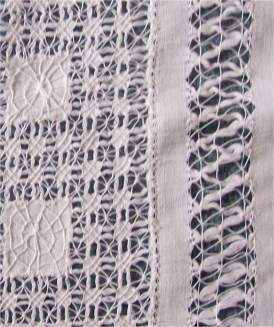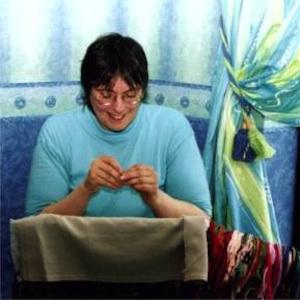- Home
- Whitework
What is whitework embroidery?
Whitework embroidery is a style of needlework stitched with white thread on white fabric, creating delicate patterns through texture, light, and shadow rather than colour.
Because normal embroidery floss is often too soft for this work, stitchers traditionally use stronger, more durable threads.
In the late 1800s, middle-class women helped popularise fine whitework on christening gowns, bonnets, nightgowns, and household linens.
One of my favourite examples is a piece of whitework embroidery my mother owns - its tiny, airy stitches show just how much detail is possible with nothing but white thread.
Whether it’s worked on a ground fabric or built up as “stitches in the air” (needlelace, or punto in aria), all of these forms fall under the umbrella of whitework.
In this introduction, we’ll look at what counts as whitework and how these techniques create such beautiful results.
Free whitework sampler
New to whitework and not sure where to start?
This free, beginner-friendly sampler walks you through seven simple bands so you can try the stitches without the pressure of a “big” project.
You’ll begin with basic filling and drawn-thread work, then build up to pulled satin and double back stitch, diamond eyelets, double backtitch leaves, honeycomb, three-sided, ringed back, and diagonal four-sided stitch.
By the time you finish the sampler, you’ll have a neat little banded piece and the confidence to tackle your first full whitework project.
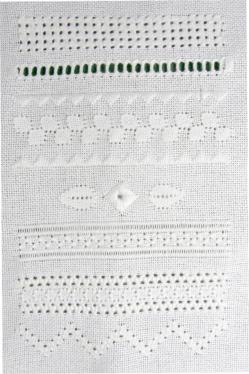
Types of whitework embroidery
The links below will take you to the relevant sections on this page.
Drawn thread work
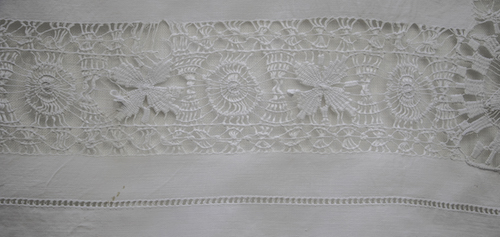
Drawn thread work is a kind of white-on-white embroidery where you literally remove threads from the fabric, then group the remaining ones into tiny clusters to create lacy windows of solid and open pattern.
Start simple with decorative hemstitching: take out threads in one direction, bundle what’s left, and you’ve got a delicate edge or insertion.
Or go further and remove threads both ways, binding the survivors into a grid and embellishing them with needleweaving or darning.
That open, lacy area is called a withdrawn ground - the same kind of detail you see on old baby caps, bonnets, and christening gowns.
Band two of the free sampler above goes into more detail about drawn thread work.
Pulled thread embroidery
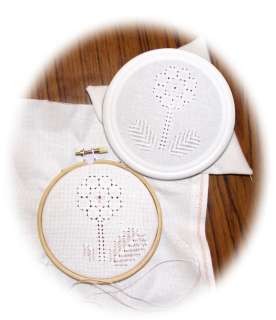
If drawn thread work removes threads, pulled thread work simply shifts them. Also called drawn fabric, it relies on tight stitches that tug the threads into tiny bunches so the holes between them form the pattern.
Because the beauty lies in the distortion of the fabric itself, not in the stitches, pulled thread work doesn’t really work in colour - the stitching should disappear.
My gentle pulled work introduction page gives you a chance to try it out and see the difference for yourself. No scary cutting involved here.
Hardanger Embroidery
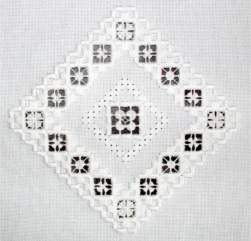
Hardanger embroidery takes its name from the region in Norway where it began, but its real magic lies in how it layers techniques you already know.
It combines pulled and drawn thread work with satin stitch motifs and blocks, first removing fabric threads, then wrapping or needleweaving the ones that remain so lacy stitches can fill the gaps.
Traditionally used on aprons, clothing, and household linens, Hardanger patterns now often appear in colour too - and they still work beautifully.
Cutwork embroidery
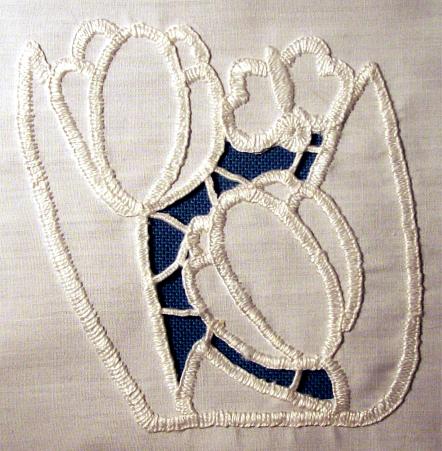
Cutwork embroidery, first recorded in the 12th century, is the quiet ancestor of later needle-made laces. For a time it was a guarded craft, worked in secret by nuns on priests’ sacramental robes and even grave cloths for saints.
By the 15th to 17th centuries, it had moved from the cloister to the parlour, as upper-class women used it for altar cloths and fine household linens.
Those early cutwork techniques didn’t disappear - they evolved, expanded, and eventually formed the foundation of the needle-made laces we know today.
Needlelace (or Needlepoint lace)
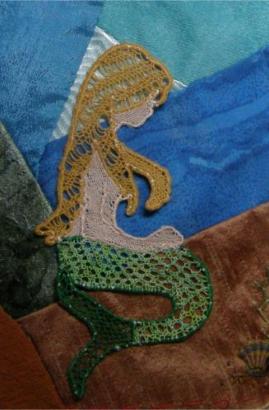
Needlelace (or needlepoint lace) is the point where earlier whitework, cutwork, and needle-made laces step off the fabric and become a lace all their own.
Growing out of those withdrawn and cut grounds, it replaces the fabric background entirely, building new shapes stitch by stitch with nothing more than thread and a needle.
Traditionally worked in fine white thread, needlelace has the same roots as early whitework and cutwork, but over time it evolved into a free-standing lace that could be as airy as cobwebs or as solid and sculptural as carved ivory, all based on the humble buttonhole or blanket stitch.
Today you’ll see it used in stumpwork embroidery, decorating crazy quilts, or forming full motifs, like my coloured mermaid in the photograph.
My friend, Liz Bartlett, kindly wrote a page that traces how needlelace developed from its whitework and cutwork ancestors into a distinct lace technique in its own right.
Richelieu embroidery
Richelieu embroidery sits between early cutwork and later needlelace, borrowing from both.
Inspired by medieval cutwork, it became popular from the 14th to 16th centuries, using buttonhole-stitched outlines around shapes with the fabric cut away inside.
The empty spaces were then bridged with buttonholed bars, often dressed up with tiny picot loops in the middle - a clear step toward the decorative fillings of needlelace.
You’ll often see Richelieu on tablecloths and mantelpiece edgings, sometimes backed with coloured fabric to show off the openwork.
Built with dense buttonhole stitches and sturdy bars, it stands up well to washing, which is why so many antique examples have survived to tell the story of how cutwork techniques gradually evolved toward true needlelace.
Reticella
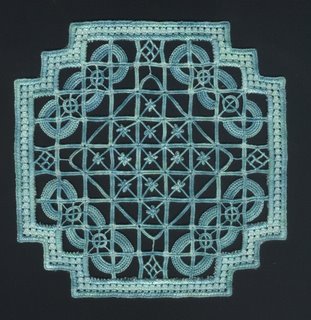
Reticella, sometimes called Greek Point, is the first needlelace to treat fabric as nothing more than scaffolding. Building on techniques like Richelieu, it uses the fabric only as a temporary support while the real lace is constructed in thread.
Threads are laid across a pattern, couched in place, then enriched with overcast stitches and picots. Once the design is complete, the ground fabric is carefully cut away, leaving a free-standing web of geometric lace that many consider the most beautiful - and one of the most time-consuming - forms of needlelace.
Historically, Reticella decorated altar cloths, church vestments, and the crisp ruffs of the 15th–17th centuries. The modern piece shown here, stitched by Jenny Bargh of Sydney from a pattern in the Italian magazine Rakam, shows how this “true” needlelace is still being interpreted today.
Hollie Point
Hollie Point is a medieval embroidery technique first worked by nuns for church laces, often filled with tiny sacred emblems such as Adam, Eve, or lilies.
Instead of drawing the motif with thread, the design in Hollie stitch appears in the spaces between the stitches, creating a mesh that looks very much like filet crochet.
This type of whitework appears to be rarely practised today.
Ready to try whitework embroidery?
After seeing all these examples, it’s easy to think whitework embroidery is only for experts with perfect eyesight and endless patience. But if you can thread a needle and work a few basic stitches, you already have enough to begin.
White thread, a simple piece of fabric, and a small starter motif or hemstitched edge are all you need to create something light, lacy, and very much your own. So yes - you really can try whitework embroidery, starting small and letting your confidence grow one tiny white stitch at a time.
Stay connected between projects
If you’d like occasional updates from my embroidery room, including new patterns, gentle tips, and little things I think you might enjoy, you’re warmly invited to join the Stitchin’ Times newsletter.
No pressure. Just a friendly note now and then to keep you inspired.
